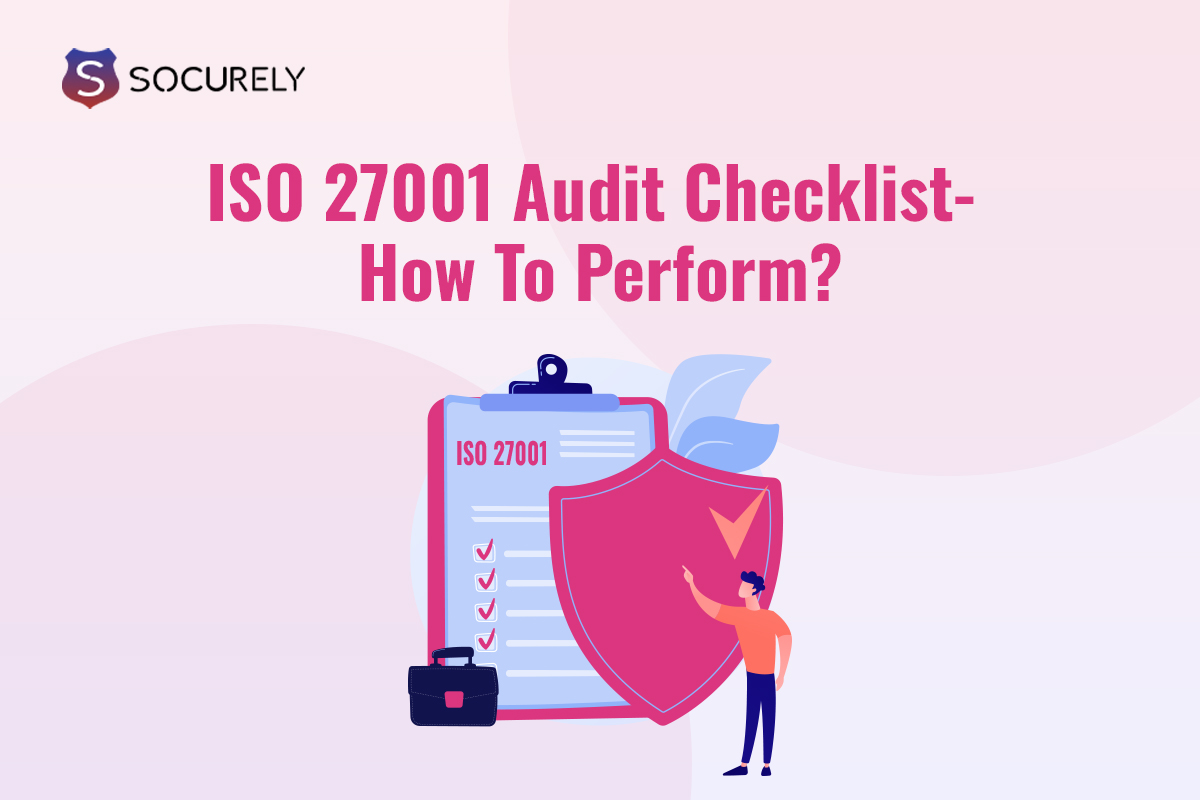ISO 27001 is the globally recognized standard for information security management, offering a robust framework for managing sensitive company information so that it remains secure. However, achieving and maintaining ISO 27001 compliance requires a thorough audit process, guided by an ISO 27001 audit checklist.
If you haven’t done the required work, your dread of audits may be justified, just as your anxiety about exams. It is typical to fear that something important has been overlooked in the process of ensuring successful certification, even after a great deal of preparation. Having an ISO 27001 audit checklist can assist soothe these anxieties and help you make sure you have complied with all criteria.
This post provides you with an overview of the ISO audit as well as an ISO 27001 audit checklist that lists specific tasks you must do to be ready for a certification audit.
What Is ISO 27001 Audit?
An ISO 27001 audit is an assessment process conducted to verify that an organization’s ISMS complies with the ISO 27001 standard. The audit is typically performed by an accredited certification body or an internal team trained in ISO 27001 standards. It involves a detailed examination of the organization’s information security policies, procedures, and controls. The audit identifies areas of non-compliance and provides recommendations for improvement. Successfully passing the audit results in ISO 27001 certification, which serves as proof of an organization’s commitment to information security.
What Is ISO 27001 Compliance Audit Checklist?
The ISO 27001 compliance audit checklist is a critical tool that helps organizations ensure they meet the requirements of the ISO 27001 standard. This checklist includes a series of steps and documentation requirements that auditors use to assess an organization’s ISMS.
The set of audit checklists aids in finding any holes or areas where your organization’s ISMS might not be completely compliant. In addition, the checklist offers a series of inquiries and standards that address the needs of the standard. A comprehensive audit is still necessary to confirm that the organization’s ISMS satisfies the standards of ISO 27001, even though an audit checklist is a useful tool in this regard.
Two categories of audits for ISO 27001 exist:
- Internal Examination
- Outside Examination
The yearly periodic surveillance audits and the recertification audit, which are completed three years after certification, are included in the external audits.
Organizations wishing to become certified must first complete an internal audit as required by ISO 27001 before they can appear before a certified external auditor.
What Is The Significance Of the ISO 27001 Audit?
The ISO 27001 standard requires periodic surveillance audits in the interim and regular internal audits in a year.
In contrast to other frameworks like SOC 2, the next ISO 27001 certification audit will be performed after the third year of qualification.
Even though these aren’t as thorough as your certification audit, you still need to be very vigilant about compliance. To know the necessity for audits, follow the included-
Validation of Commitment to Information Security: The audit confirms that an organization has effectively implemented security measures by the ISO 27001 standard.
Demonstrates Robust Security Measures: It assures stakeholders, including clients and regulatory bodies, that the organization is protecting sensitive data.
Industry-Specific Importance: Particularly critical in sectors like finance, healthcare, and government, where data breaches can have severe consequences.
Enhances Competitive Edge: ISO 27001 certification can improve the organization’s reputation, giving it a competitive advantage by building trust with clients and partners.
Protects Against Legal and Financial Risks: Successfully passing the audit helps mitigate potential legal liabilities and financial losses associated with data breaches.
Why Is ISO 27001 Audit Checklist Is Important?
Apart from the Audit significance, the audit checklist also holds some importance, like-
- Ensures Comprehensive Coverage: The checklist ensures that no critical aspect of the ISMS is overlooked during the audit preparation.
- Identifies and Rectifies Gaps: It helps organizations identify weaknesses in their security measures and address them before the formal audit.
- Facilitates Systematic Preparation: The checklist provides a structured approach to audit preparation, ensuring all necessary documentation and controls are in place.
- Serves as a Reference for Auditors: It guides auditors in conducting a thorough and consistent evaluation across all areas of the organization.
- Increases Chances of Audit Success: By following the checklist, organizations can better prepare for the audit, reducing the risk of non-compliance and audit failure.
What Are the Checklist Items for an ISO 27001 Audit?
- Information Security Policies: Ensure all relevant policies are documented, communicated, and regularly reviewed.
- Risk Assessment and Treatment: Verify that a risk assessment has been conducted, and appropriate risk treatment plans are in place.
- Asset Management: Confirm that all information assets are identified, classified, and managed according to their importance and sensitivity.
- Access Control: Check that access to information and systems is restricted based on roles and responsibilities, with clear authorization processes.
- Human Resource Security: Ensure that employees are trained on information security practices and that their roles and responsibilities are clearly defined.
- Physical and Environmental Security: Review the security measures in place to protect physical assets and data centers from unauthorized access and environmental threats.
- Operations Security: Verify that procedures for managing day-to-day operations, including backups, change management, and malware protection, are in place.
- Communication Security: Confirm that the security of communications, including data transfer and network security, is adequately protected.
- Incident Management: Ensure that there is a documented process for reporting, managing, and resolving security incidents.
- Business Continuity Management: Check that plans are in place to ensure business continuity in the event of a major disruption.
- Compliance: Review the organization’s adherence to legal, regulatory, and contractual obligations related to information security.
How To Get ISO 27001 Audit Checklist?
Obtaining an ISO 27001 audit checklist involves several steps:
Identify the Scope of the Audit-
Determine the boundaries of your ISMS, including the processes, departments, and information assets that will be covered by the audit. This will help you tailor the checklist to your organization’s specific needs.
Form an internal group-
Assemble an internal resource team to lead your company’s compliance process and serve as a point of reference for the certification audit. Heads of People Operations, Security Officers, and IT departments, among others, might be on this team.
This group would be involved in all phases of the ISMS’s design, construction, and oversight. Consequently, during the certification audit, is in the greatest position to respond to the questions posed by the external auditor.
Align ISMS Scope and Plan-
Work together with department leaders and go over the details of your ISO 27001 certification. The information, goods, procedures, services, systems, roles, affiliates, and regions that your company needs to safeguard with its ISMS may serve as the basis for this. Make sure the scope includes all the data that your company wants to safeguard with an ISMS. Look for the results of internal audits about this matter, then take the advice to heart.
Examine the documentation-
Verify that management has seen and approved each of the several ISO 27001 papers, including the Information Security Policy, Risk Treatment Plan, and Statement of Applicability, to mention a few. Additionally, record all policies and make them accessible to all employees on the corporate intranet.
Gathering of evidence-
To prove compliance with the ISO standard standards, make sure there is a trail of papers and records and that proof is gathered. For example, post policies on the corporate intranet that pertain to vendor risk management, change management, data backup, business continuity, vulnerability management, and data retention, among others, and make them accessible to all employees.
Review and Update Regularly-
The audit checklist should be a living document, updated regularly to reflect changes in your ISMS or new ISO 27001 requirements.
Include the results of internal audits-
Examine the internal audit report, making sure to take into account all of the conclusions, suggestions, and remedial measures. One of the first things your external auditor would check for during the primary audit would be your internal audit report.
Inquire about the following throughout the audit:
- Are industry-standard encryption and HTTPS (TLS algorithm) being used to safeguard user access to your application?
- Is it the case that every year top management evaluates and approves all corporate policies?
- Is information security awareness training completed by all employees both at the time of recruitment and on an annual basis?
Smartly Get Your ISO 27001 Audit Reports Ready!
Ensuring that your organization is fully prepared for the ISO 27001 audit can be a daunting task. However, with the right tools and expertise, you can streamline the process and achieve compliance more efficiently. Socurely offers comprehensive solutions to help you prepare for your ISO 27001 audit. From providing customizable audit checklists to offering expert consultation, Socurely ensures that your audit process is smooth and successful. Our platform also automates many aspects of the ISMS management process, reducing the burden on your team and allowing you to focus on what matters most—protecting your organization’s information assets.
Wrapping Up
Any organization committed to information security should strive for ISO 27001 certification. The audit process, guided by a detailed audit checklist, is critical to achieving this certification. By understanding the importance of the audit checklist and following the steps outlined in this guide, your organization can confidently navigate the audit process and secure its place among the ranks of ISO 27001-certified companies.
FAQ
What is the audit cost for ISO 27001?
The cost of an ISO 27001 audit can vary significantly based on factors such as the size and complexity of your organization, the scope of the ISMS, and the auditor’s fees. On average, the cost can range from a few thousand to tens of thousands of dollars. It’s essential to budget for both the initial certification audit and ongoing surveillance audits to maintain your certification.
Who needs to comply with ISO 27001?
ISO 27001 compliance is crucial for any organization that handles sensitive information, including financial data, personal information, and intellectual property. This includes businesses in the finance, healthcare, IT, and government sectors. Compliance is particularly important for organizations that wish to demonstrate their commitment to information security to clients, partners, and regulatory bodies.
How To Behave In The Middle Of An ISO 27001 Audit?
During an ISO 27001 audit, it’s important to maintain professionalism and transparency. Some include-
- Be Prepared: Ensure all documentation is readily available and accessible to the auditors.
- Be Honest: If you don’t know the answer to a question, it’s better to admit it and find the correct information than to guess.
- Be Cooperative: Work collaboratively with the auditors, providing them with the information they need promptly.
- Stay Calm: Audits can be stressful, but staying calm and composed will help the process go smoothly.
- Ask Questions: If you’re unsure about any part of the audit process, don’t hesitate to ask the auditors for clarification.







